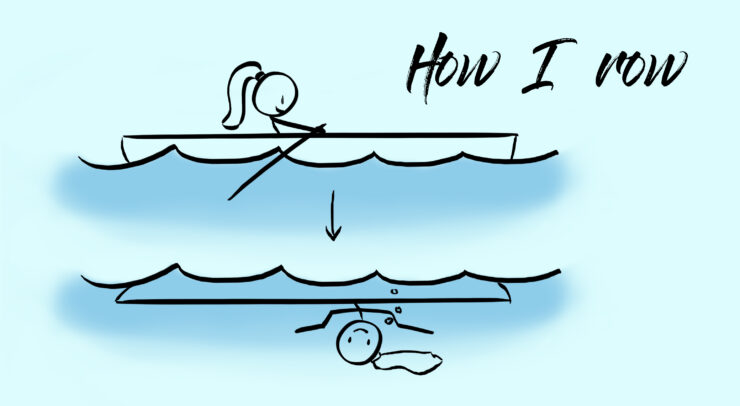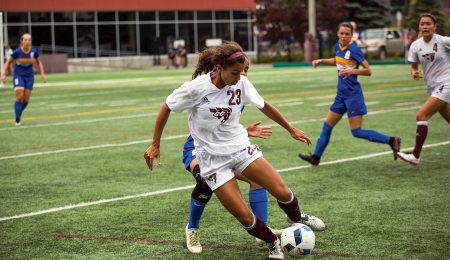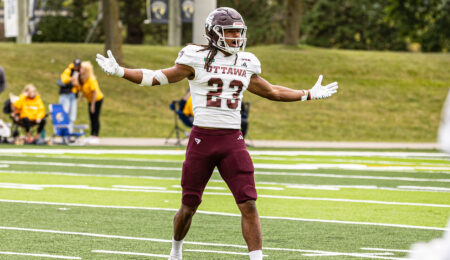Row, row, rowing with the Gee-Gees
This week, I tried out for the University of Ottawa novice women’s rowing team. Why did I try out? Our story begins during frosh week. While volunteering, I met the president of the rowing team, Khorina Khov, who was passionately preaching the magic and miracles of the sport. Since I happened to be available for the first day of tryouts, I decided to attend. The tryout consisted of a few generic fitness, coordination, and flexibility exercises.
Against all odds and expectations, I was called back for the on-water tryouts. This is how I found myself sitting in a boat, in the dark, at 5 a.m. the next morning.
The history of the sport goes back as far as Ancient Egypt. The first “modern” races occurred in the medieval times, when boatmen would challenge each other to see who was faster at ferrying people across the water. It eventually found its way to the UK, where it became an upper-class sport. This is one of the aspects that fascinated me most. As it goes so far back, the sport is rich in history and tradition.
The good news, I learned, is that there are no flying objects in this sport, which drastically decreases your chance of getting concussed. The bad news is that you’re sitting in a boat not much wider than the width of your hips, essentially balancing on your two butt-cheeks in the middle of the ocean. (It may actually just be a river; I am no expert in the field of limnology).
The other challenge I faced was learning the right terminology. Who came up with the idea of naming parts of a boat: port, starboard, stern and bow? As a person who still struggles with figuring out left and right, I did not appreciate the four extra directions thrust upon me.
The boat that I rowed sat eight people, facing backwards, single-file from foot to waist. Unlike what I originally imagined, rowing relies more on the legs than the arms. Each person sits in a sliding seat, holding an oar. To row, the athlete dips the oar into the water and pushes with their legs, straightening their knees.
We started by doing a couple drills to learn how to balance the boat. The novice team usually rows in teams of eight, the largest boat since it’s the hardest to flip. Hardest, but not impossible, as proven by the Carleton novice men’s team in the first week of practice, those suckers. Eventually, we progressed to doing a couple strokes in the water. Soon enough, all eight of us were rowing full-out.
It was hard and frustrating work, especially in the beginning. I’d never done a sport that engaged pretty much every single muscle group in the body, while requiring precise coordination with seven other people of varying shapes and sizes.
After some hard work and sweat, the reward came as all eight of us were moving our oars in perfect synchronicity and were flying across the river. As we skimmed the water, a gorgeous purple-pink sunrise rose over Parliament Hill, completely taking my breath away. (Honestly, it may have been the exercise that was taking my breath away.)
“It’s not all about the pretty sunrises. It’s about being a part of a team that’s about success and winning. At the end of the day, you want to be a part of something,” Stu McKenzie, coach of the women’s varsity rowing team said.
The coaches are not only concerned with the competitive lives of their athletes, but also take time to support them in maintaining a healthy work-life balance.
“If there are skills that they can take from the sport and apply to real life, then I did my job as a coach. You make better people and better students,” McKenzie explained.
“What can you bring? Just a good spirit, a good work ethic, motivation, willingness to learn a new skill and adapt and be malleable. Our philosophy is pretty simple, the kids that work hard are going to get more opportunity. Within five to six years, you could be in the Olympics, if you work really hard.”
Though I haven’t been rowing for long, I have completely fallen in love with the sport. If anyone needs me, I can be found in the middle of the Ottawa River between the hours of 5-8 a.m. every morning come hell or high water, no pun intended.
The University of Ottawa rowing team accepts novices who have no rowing experience, as well as varsity athletes. Off-season training, which is open to all students, will begin in November 2018 at Montpetit gym. Tryouts for next season will start August or early September 2019. For more details, email vprecruitment.uottawarowing@gmail.com.





